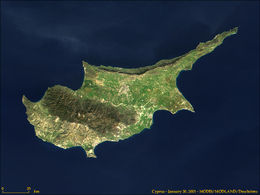

Cyprus
Over the p ast
20 years there have been a number of discoveries that have greatly enhanced our
knowledge of the early prehistory of Cyprus. Currently, the earliest confirmed
site of human activity on the island is Aeotokremnos situated on the
Akrotiri Peninsula on the south coast. Evidence from this site indicates that
hunter-gatherers were active on the island from around 10,000 BC. There is also
new evidence that suggests that there may be short lived occupation sites
contemporary with Aeotokremnos on the west coast of the island in the area of
the Akamas.
ast
20 years there have been a number of discoveries that have greatly enhanced our
knowledge of the early prehistory of Cyprus. Currently, the earliest confirmed
site of human activity on the island is Aeotokremnos situated on the
Akrotiri Peninsula on the south coast. Evidence from this site indicates that
hunter-gatherers were active on the island from around 10,000 BC. There is also
new evidence that suggests that there may be short lived occupation sites
contemporary with Aeotokremnos on the west coast of the island in the area of
the Akamas.
At present the archaeological record presents us with a chronological gap in the use or occupation of the island between the earliest hunter-gatherers and the appearance in the record of more settled village pastoralists at around 8200 BC. These people probably practiced a limited form of agriculture and animal husbandry, supplemented by hunting. Important remains from this early-Neolithic period can be found at Mylouthkia, Shillourokambos, and Tenta and later towards the end of this period the famous village of Khirokitia.
During the
proceeding Painted-Pottery Neolithic and Chalcolithic periods small scale
settlements and activity areas were in use all over the island. During this
period the people of Cyprus developed a rich craft industry producing decorated
pottery and figurines of stone quite distinct from the cultures of the
surrounding mainland. This has traditionally lead some Archaeologists to
consider the island as being somewhat isolated and insular at this time. Whereas
more recently this idea is being challenged.
The Bronze Age is also rich in finds. The people learned to work the rich copper mines of the island. The MycenŠan culture seems to have reached Cyprus at around 1600 BC and several Greek and Phťnician settlements that belong to the Iron Age can be found on the island. Cyprus came into contact with Egypt about 1500 BC and became an important trade partner.
Around 1200 BC, the Sea Peoples may have arrived in Cyprus, although the nature of their influence is disputed. The Phťnicians arrived at the island in the early first millennium BC. In those times, Cyprus supplied the Greeks with timber for their fleets.
In the sixth century BC, Amasis of Egypt conquered Cyprus, which soon fell under the rule of the Persians when Cambyses conquered Egypt. In the Persian Empire, Cyprus formed part of the fifth satrapy and in addition to tribute it had to supply the Persians with ships and crews. In their new fate, the Greeks of Cyprus had as companions the Greeks of Ionia (west coast of Anatolia) with whom they forged closer ties. When the Ionian Greeks revolted against Persia (499 BC), the Cypriots, except for the city of Amathus, joined in led by Onesilos who dethroned his brother, the king of Salamis, for not wanting to fight for independence. The Persians reacted quickly, sending a considerable force against Onesilos. The Persians finally won despite Ionian help.
After their defeat, the Greeks mounted various expeditions in order to take Cyprus from Persian rule, but all their efforts bore only temporary results. Eventually, under Alexander the Great (356-323 BC) the island went over to the Macedonians. Later, the Ptolemies of Egypt controlled it; finally Rome annexed it in 58-57 BC. Cyprus was visited by the Apostles Paul and Barnabas accompanied by St Mark who came to the island at the outset of their first missionary journey in 45 AD. After their arrival at Salamis they proceeded to Paphos where they converted the Roman Governor Sergius Paulus to Christianity, making Cyprus the first country in the world governed by a Christian ruler.
Holy Land Greece Pilgrimages Pilgrimages Map Index Espa˝ol English Index